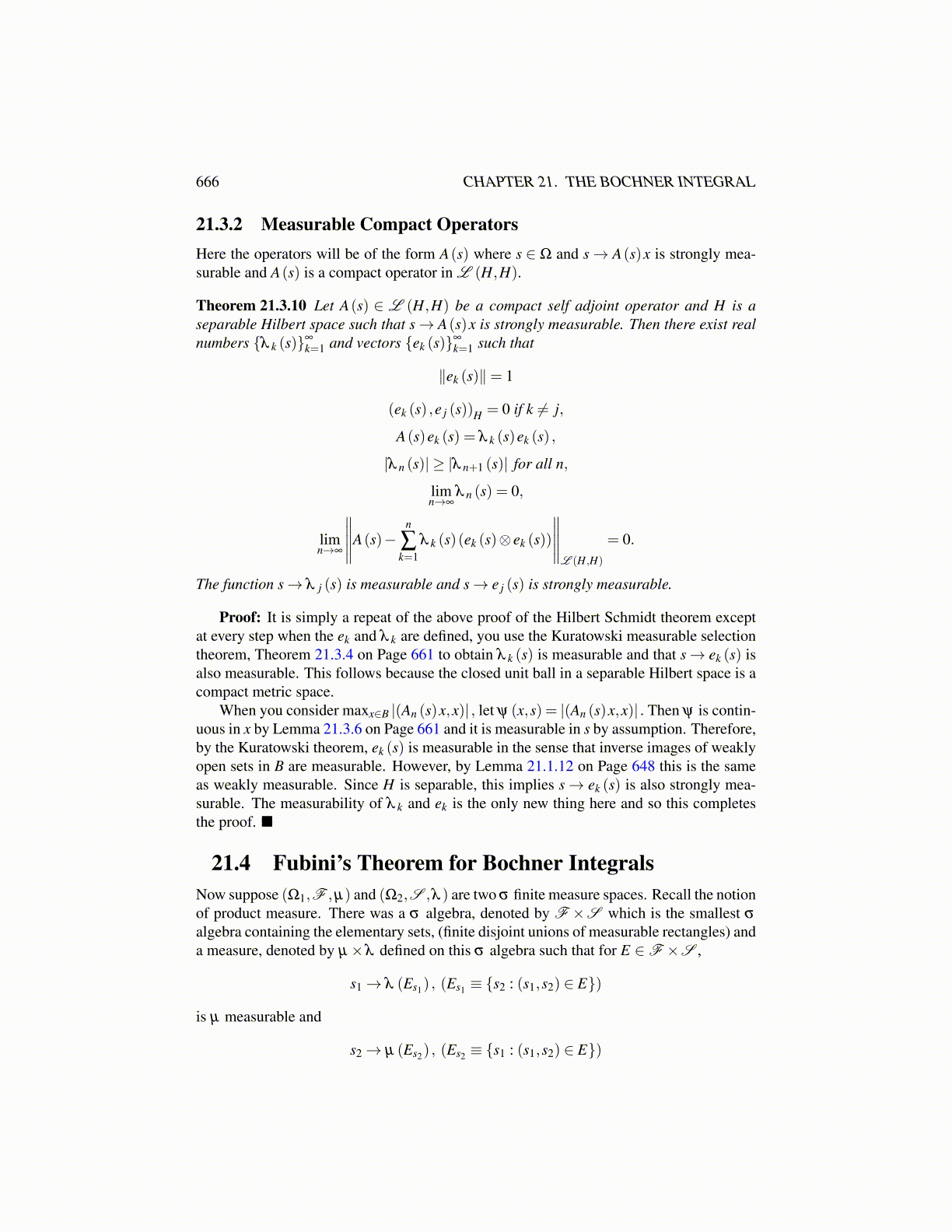
666 CHAPTER 21. THE BOCHNER INTEGRAL
21.3.2 Measurable Compact OperatorsHere the operators will be of the form A(s) where s ∈ Ω and s→ A(s)x is strongly mea-surable and A(s) is a compact operator in L (H,H).
Theorem 21.3.10 Let A(s) ∈ L (H,H) be a compact self adjoint operator and H is aseparable Hilbert space such that s→ A(s)x is strongly measurable. Then there exist realnumbers {λ k (s)}∞
k=1 and vectors {ek (s)}∞
k=1 such that
∥ek (s)∥= 1
(ek (s) ,e j (s))H = 0 if k ̸= j,
A(s)ek (s) = λ k (s)ek (s) ,
|λ n (s)| ≥ |λ n+1 (s)| for all n,
limn→∞
λ n (s) = 0,
limn→∞
∥∥∥∥∥A(s)−n
∑k=1
λ k (s)(ek (s)⊗ ek (s))
∥∥∥∥∥L (H,H)
= 0.
The function s→ λ j (s) is measurable and s→ e j (s) is strongly measurable.
Proof: It is simply a repeat of the above proof of the Hilbert Schmidt theorem exceptat every step when the ek and λ k are defined, you use the Kuratowski measurable selectiontheorem, Theorem 21.3.4 on Page 661 to obtain λ k (s) is measurable and that s→ ek (s) isalso measurable. This follows because the closed unit ball in a separable Hilbert space is acompact metric space.
When you consider maxx∈B |(An (s)x,x)| , let ψ (x,s) = |(An (s)x,x)| . Then ψ is contin-uous in x by Lemma 21.3.6 on Page 661 and it is measurable in s by assumption. Therefore,by the Kuratowski theorem, ek (s) is measurable in the sense that inverse images of weaklyopen sets in B are measurable. However, by Lemma 21.1.12 on Page 648 this is the sameas weakly measurable. Since H is separable, this implies s→ ek (s) is also strongly mea-surable. The measurability of λ k and ek is the only new thing here and so this completesthe proof.
21.4 Fubini’s Theorem for Bochner IntegralsNow suppose (Ω1,F ,µ) and (Ω2,S ,λ ) are two σ finite measure spaces. Recall the notionof product measure. There was a σ algebra, denoted by F ×S which is the smallest σ
algebra containing the elementary sets, (finite disjoint unions of measurable rectangles) anda measure, denoted by µ×λ defined on this σ algebra such that for E ∈F ×S ,
s1→ λ (Es1) , (Es1 ≡ {s2 : (s1,s2) ∈ E})
is µ measurable and
s2→ µ (Es2) , (Es2 ≡ {s1 : (s1,s2) ∈ E})